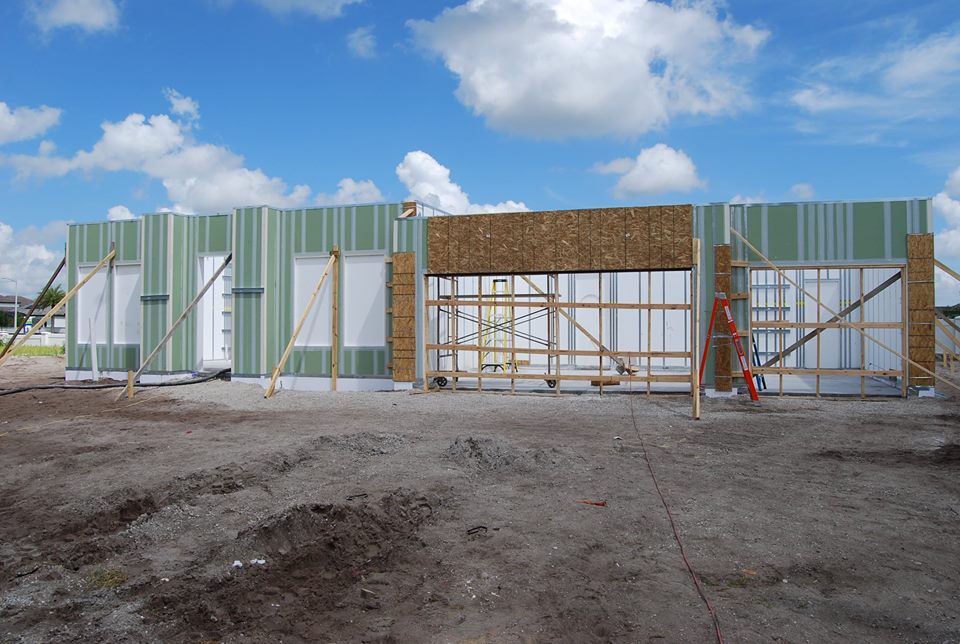Other industries have evolved faster than the home building industry in terms of materials and processes. For instance, the first cars had wood frames. Shortly afterward, they were redesigned to be more flexible and more resilient. The transition in cars from wood to steel started in 1900, and since then, automobiles have seen continuous improvement in construction materials for safety, durability, and performance.
So why the huge gap in applying new materials between how cars are built versus how homes are built? And why have centuries passed without much disruption to the home building process? Meritage Homes is working toward new ideas in home performance with the reNEWable Living Home, the 2018 BUILDER concept project.
For the project, Meritage wants to forgo the use of age-old construction products, instead constructing an exterior made from steel, concrete, and expanded polystyrene insulation. These materials are not as prone to sources of failure like natural variable material or degradation from exposure to natural forces like water, humidity, bugs, and decay. Plus, the materials are more predictable, offering better engineering and consistency, so it can perform the way it was designed from the beginning. These materials provide a house that is healthier, stronger, and less susceptible to molds and allergens. It’s also easier to construct than a conventional home.
A Champion for the Industry
The project is a demonstration of concepts to inspire volume home building for a better future. “This project taught us to build homes with better materials that demonstrate less cost and a faster process than materials and methods commonly used today,” says CR Herro, vice president of environmental affairs at Meritage Homes. “All we had to do is pick up our heads and do something new. It’s inspiring to do it now and disappointing that we haven’t before this, all at the same time.”
The reNEWable Living home was designed with the intention that it would last a couple of hundred years from materials that have a low carbon cost. The project aspires to be the new standard for the way homes are built so that there is less waste. What Meritage focused on for the reNEWable Living Home was very strategic. “We wanted to ensure that everything that we demonstrated could be done 10,000 times with materials available today,” Herro says. “It all had to be easy and cost effective for any builder to emulate.”
That also meant studying the history of engineering and focusing on materials with at least 50 years of use as construction materials. “We only used well-studied materials that have very known properties, and opened them to use in new ways to better leverage final results,” Herro says.
The base components for the development of the reNEWable Living Home are concrete, steel, and plastic compounds that have been used in other industries for many years with predictable results. These materials also have known chemistries to make sure there are not any unknown VOCs or negative reactions to new products. Typically, Herro explains, Meritage vets all possible technology to make sure it is well understood for decades of time within a building and in different climate zones.
What The Future Holds
Herro predicts that the interior components will change similar to the shell, moving to light gauge steel or SIPs from less durable wood wall systems. Those innovations also will impact roofing and cladding materials. New materials are available for SIPs, precast systems, and aesthetic surfaces that may start to replace the field-installed, conventional materials that are common today. These structures would be cast into their final form, being much more purposefully manufactured for better function and less waste—all of which leads to a better product with a faster, less expensive construction methodology, Herro says.

OX SI-Strong Structural Insulation combines a moisture-resistant grey foil outside face, a polyisocyanurate foam core, and structural sheathing. Builders can use 1-inch (R-5.5) panels to sheathe entire exteriors. www.oxengineeredproducts.com
Window and door suppliers are capturing innovative new materials to reduce degradation and to improve performance. In the future, windows and doors will have better frame and insulative materials, and incorporate transparency changing glass. Meritage Homes has its sights set on dynamic glass, treated with an electrochromic coating that responds to the environment and the user. The glass controls glare, heat, daylighting, and privacy automatically or from a handheld smart device.
Today, automobiles utilize innovative materials to last longer, drive faster, use less fuel, and protect the occupants. Homes are where we raise our families, celebrate special occasions, and rest and recuperate. Readily available new materials provide an opportunity to greatly improve how a home functions to make the lives better for the people who live in them.
The development of the reNEWable Living Home is unfolding at www.builderonline.com/renewable and the project will be available to tour in Orlando in January 2018.



